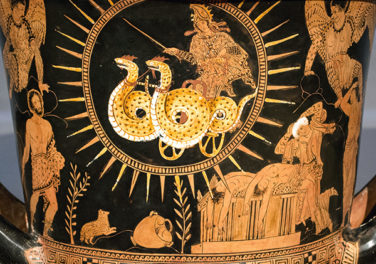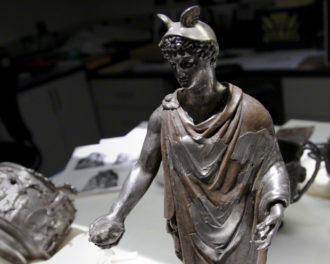
Nothing says “funny” like a miscreant slave mask. Lamp in the Shape of a Comic Mask, Roman, A.D. 75–125. Bronze, 4 15/16 in. high. The J. Paul Getty Museum, 96.AQ.193. Gift of Barbara and Lawrence Fleischman
Throughout 2013, the Getty community participated in a rotation-curation experiment using the Getty Iris, Twitter, and Facebook. Each week a new staff member took the helm of our social media to chat with you directly and share a passion for a specific topic—from museum education to Renaissance art to web development. Getty Voices concluded in February 2014.
Although we may never know what inspired the phrase “laughter is the best medicine,” we can say with some certainty that whoever said it wasn’t 1) a doctor, or 2) bleeding profusely. Because for all of laughter’s physiological advantages, you’re just not going to dress a bad injury with a tourniquet of knock-knock jokes. (It’s also said that laughter is infectious, but how are you supposed to treat the infection if the medicine is the same as the problem?)
Of course, there’s quite a lot of truth in that little statement. While we’ll never cure the common cold with a cleverly worded pun, or treat a child’s chicken pox by having them listen to an Eddie Izzard routine, the effects of laughter on the human body are, by and large, extremely positive. The simple act of throwing one’s head back and engaging in an extended belly-laugh opens up blood vessels, boosts one’s immune system, releases the body’s endorphins, and relaxes you for up to 45 minutes. All that from a good chuckle!
The ancient Greeks and Romans, who likely knew less about the physiological effects of laughter than we do, nevertheless understood the importance of laughter in making life more bearable 2,000 years ago. Whether in the theater performed by a professional comedic troupe, or simply as graffiti on the side of a public building in Pompeii, comedy and humor were as prevalent in antiquity as they are today. And although the Greeks and the Romans are separated from us by thousands of years and miles, it’s clear that laughter was as important to them as it is to us.
The cultures of ancient Greece and Rome were highly stratified and hierarchical. At the top, of course, were the politically powerful and financially stable men of each society. Below them was everybody else, from women, to foreigners, to slaves, to criminals. And while the lower classes rarely passed up an opportunity to mock or devalue the top men of society—through, for example, theater or song—the upper classes also used humor, often as a tool to continue consolidating their power and prestige. Their humor wasn’t always pretty (hardly ever, actually) and it was often violent; but like all humor, it was almost always reflective of the ideals of the greater society.
Like these pretty-darn-terrible jokes from the 1,600-year-old joke book Philogelos, which I perform here. You have been warned.
This week on Getty Voices, I invite you to explore some of the ways in which the people of antiquity amused themselves. It will often be crass, childish, and (as I’ve already said), hostile and violent. But more importantly, a surprising amount of it is still be relatable to the 21st-century man or woman. So while we may no longer gather to enjoy a public execution intended to make us laugh (no, really), we can think about how today, especially, we still enjoy humor at someone else’s expense. And while we may have become more “civilized” over the past 2,000 years, there’s no denying that we all still like to play the fool from time to time—or even better, to watch others do it.
Connect with more “The Ancient Funny” content:
- Get silly with #Ancientworldproblems




David Misch here, author of “Funny: The Book” (“You must buy this book immediately!” — Some Celebrity Who Ordinary People Are Really Impressed By); Eric asked me to take a look at the April Fool’s Week posts.
Right off, I have a question: I know public executions have been, at various points through history, seen as entertainment but I wasn’t aware they were supposed to be funny. Izzat true?
Hi David! Thanks for the question. As hard as it is to believe, the Romans often conducted public executions of condemned criminals during their day-long games in the arena or Colosseum. The executions were planned at mid-day as a “respite” from the beast hunts and gladitorial combat that preceded and followed them. The public nature of these executions would have acted like a deterrent, but they would have also served to entertain the public. A very famous example of a public execution in the arena describes a condemned criminal being dressed as Daedalus, the mythical father of Icarus. The criminal was outfitted with wings on his arms and was hoisted high above the sand floor, before he was released and plummeted to the ground flapping his arms/wings in vain. The Roman viewer, familiar with the original story of Icarus falling from the sky, would have had a good chuckle at the reversal of this myth, in which the father now pays the ultimate price. A story about the importance of listening to one’s elders is turned on its head in what was, for the Romans, a humorous fashion.
Author John R. Clarke covers public executions and other forms of “humorous” entertainment in his book, “Looking at Laughter: Humor, Power, and Transgression in Roman Visual Culture, 100 BC – AD 250.” (University of California Press, 2007). Excellent resource.
Really interesting. Of course the question of how far we’ve progressed is an open one; for instance, laughing at other people’s troubles is not entirely unknown in the world of “reality” television.
It’s funny because Abderites are dumb.